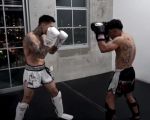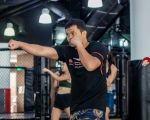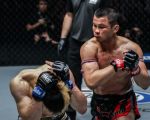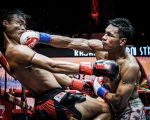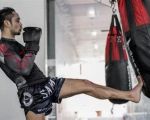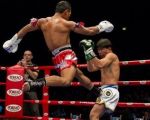Muay Thai Defense Techniques: Master the Best Defensive Skills for Protection and Counterattacks
- 1. The Importance of Defense in Muay Thai
- 2. Key Defense Techniques in Muay Thai
- 3. The Muay Thai Guard and Its Role in Defense
- 4. Counterattacking Strategies in Muay Thai
- 5. Real-Life Examples of Effective Defense in Muay Thai
- 6. How to Improve Your Defense in Muay Thai
1. The Importance of Defense in Muay Thai
In Muay Thai, offense often grabs the spotlight, with explosive strikes, powerful kicks, and devastating elbows. However, defense is just as important. The ability to protect yourself, avoid damage, and create openings for counterattacks is what makes a great fighter. Good defense allows you to control the pace of the fight, conserve energy, and avoid unnecessary damage, giving you the advantage when it's time to strike.
Defense in Muay Thai is not just about blocking; it’s about using the right techniques to stay safe while maintaining the ability to strike effectively. With solid defense, a fighter can withstand attacks and counter with precision, taking control of the match.
2. Key Defense Techniques in Muay Thai
Muay Thai defense is built around several key techniques that allow fighters to minimize damage while setting up opportunities for offense. Some of the most crucial defense techniques include:
- Blocking: Blocking is a fundamental defensive skill that involves using your arms, forearms, and legs to absorb or deflect incoming strikes. A well-timed block can neutralize the impact of punches, kicks, and elbows, protecting vital areas like the head and torso.
- Parrying: Parrying involves redirecting an opponent’s strike with a quick, controlled motion. By using your hands or forearms, you can deflect punches and kicks away from your body, creating openings for your own attacks.
- Evading: Evasion is one of the most effective ways to defend yourself in Muay Thai. This involves slipping, ducking, or moving out of the way of an incoming strike. Evasion allows you to stay out of range while maintaining the ability to counterattack immediately.
- Covering: Covering is a defensive technique where you protect your head and body by bringing your arms close to your face and chest. It’s often used when you’re caught in a defensive position or need to absorb multiple strikes. The goal is to minimize damage while waiting for an opening.
3. The Muay Thai Guard and Its Role in Defense
The Muay Thai guard is a critical component of a fighter's defense strategy. Unlike other martial arts, the Muay Thai guard is unique due to its combination of high and low guard positions. The guard is designed to protect the head, torso, and legs while also allowing for quick transitions into offensive techniques.
The typical Muay Thai guard includes:
- High Guard: The hands are held high to protect the head and face from punches, elbows, and kicks. This guard allows for a solid defense while keeping the fighter ready to counterattack.
- Low Guard: In some situations, fighters may lower their guard to defend against low kicks or to bait their opponent into attacking. The low guard also opens up opportunities to launch fast counters or deliver a strong body strike.
Mastering the Muay Thai guard and understanding when to switch between high and low guard positions is essential for both defense and counterattacks.
4. Counterattacking Strategies in Muay Thai
While defense is essential for avoiding damage, counterattacking is what allows you to take advantage of openings created by your opponent's attacks. In Muay Thai, counterattacks are a critical part of the game. The key to successful counterattacking lies in timing and precision. Here are some popular counterattacking strategies in Muay Thai:
- Counter Punching: When your opponent throws a punch, you can evade or block the strike and immediately counter with your own punch. Timing is everything here, as you need to strike before your opponent can recover from their attack.
- Counter Kicking: A well-timed counter kick can be devastating. By parrying or blocking an opponent's kick, you can immediately respond with a counterkick, often to the opponent’s head or body.
- Elbow Counter: When an opponent throws a punch, you can slip and close the distance to land a sharp elbow strike. The close range of an elbow makes it a perfect tool for counterattacking after evading a punch.
- Clinch Counter: In the clinch, where both fighters are close and tied up, you can use your opponent's momentum against them, either by sweeping or kneeing them when they try to engage or strike.
Counterattacking requires patience and awareness of your opponent’s movements, but when executed correctly, it can turn the tide of the fight in your favor.
5. Real-Life Examples of Effective Defense in Muay Thai
Effective defense is often the hallmark of top Muay Thai fighters. One such example is the legendary Saenchai, known for his impeccable defense and counterattacking abilities. Saenchai is renowned for his ability to read his opponent's attacks and immediately slip, block, or parry strikes, turning defense into offense in a split second.
Another example is the famous Muay Thai fighter Buakaw Banchamek, who combines a solid guard with sharp counters. Buakaw’s ability to defend against powerful kicks while immediately launching a counterattack has earned him widespread recognition and success in the ring.
These fighters showcase how important it is to combine solid defense with offensive techniques to be effective in the ring.
6. How to Improve Your Defense in Muay Thai
Improving your defense in Muay Thai takes time, practice, and consistency. Here are some key strategies to help enhance your defensive skills:
- Drill Defensive Movements: Consistent practice of blocking, parrying, and evading is crucial. Focus on specific drills that simulate real fight scenarios, allowing you to react quickly to different attacks.
- Work on Reaction Speed: Defense in Muay Thai is all about timing. The faster you can react to an opponent’s attack, the better your defense will be. Use reaction-based training tools, such as reaction balls or sparring drills, to improve your speed.
- Develop a Strong Guard: Mastering the Muay Thai guard is essential for defending against attacks. Work on your guard positions and practice transitioning between high and low guard to suit different situations.
- Analyze Your Opponent: Study your opponent’s tendencies and attacks. The more you know about their style, the better you can defend and counter effectively.
By incorporating these strategies into your training, you can steadily improve your defense and become a more well-rounded fighter in Muay Thai.
If you're looking to enhance your Muay Thai defense techniques, visit Humble Challenger for expert training programs and tips tailored to help you develop your defensive skills.














